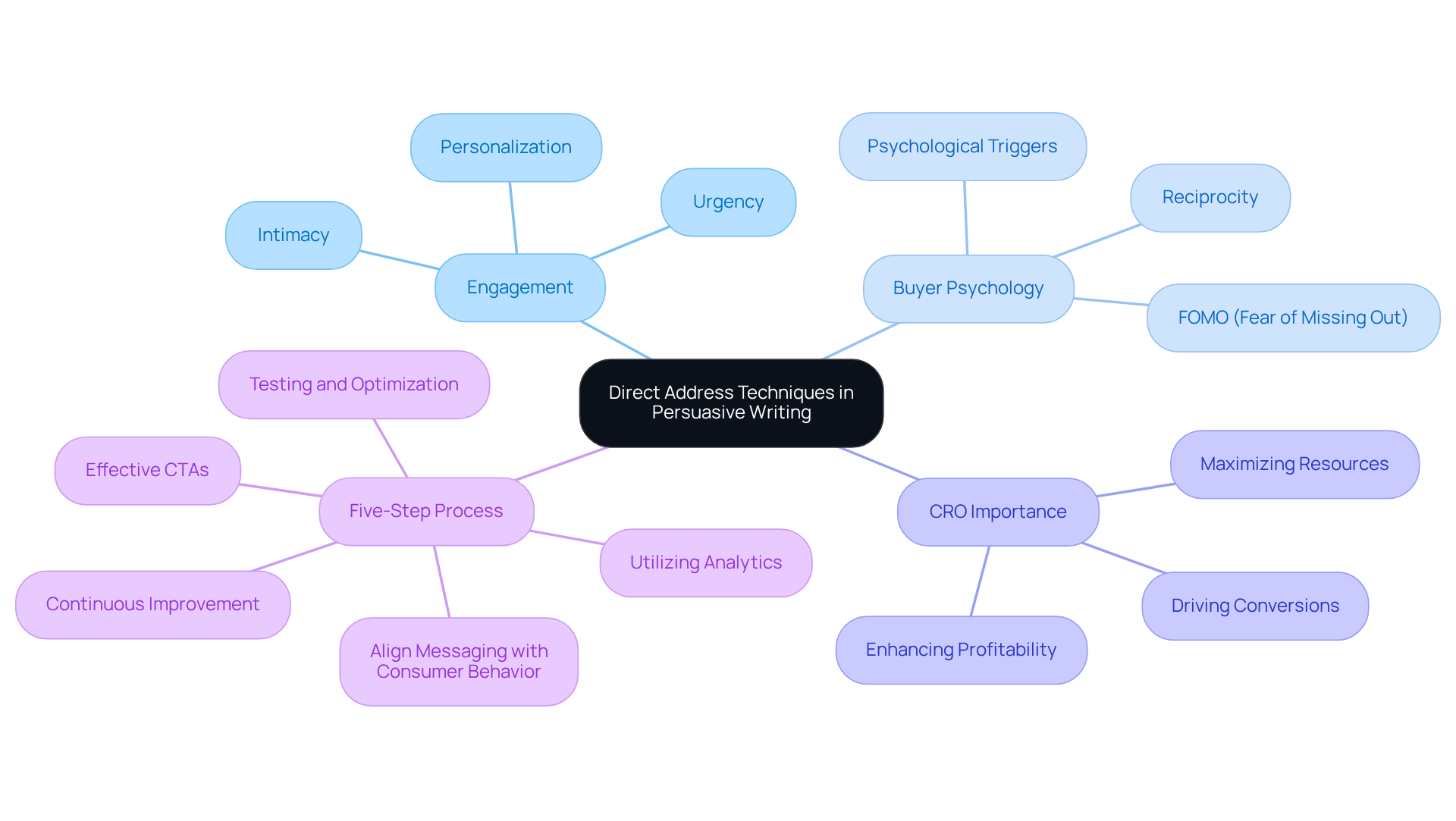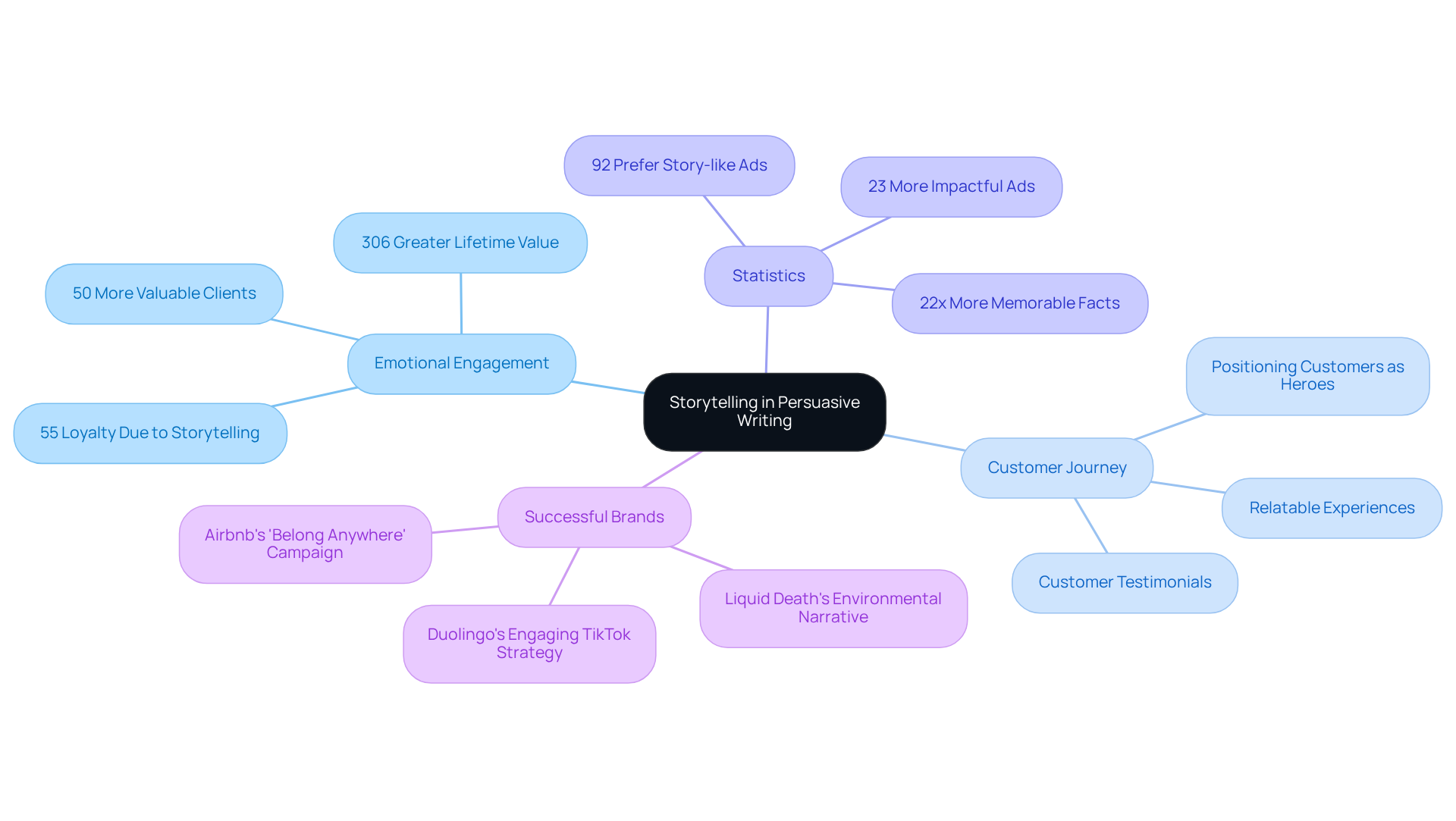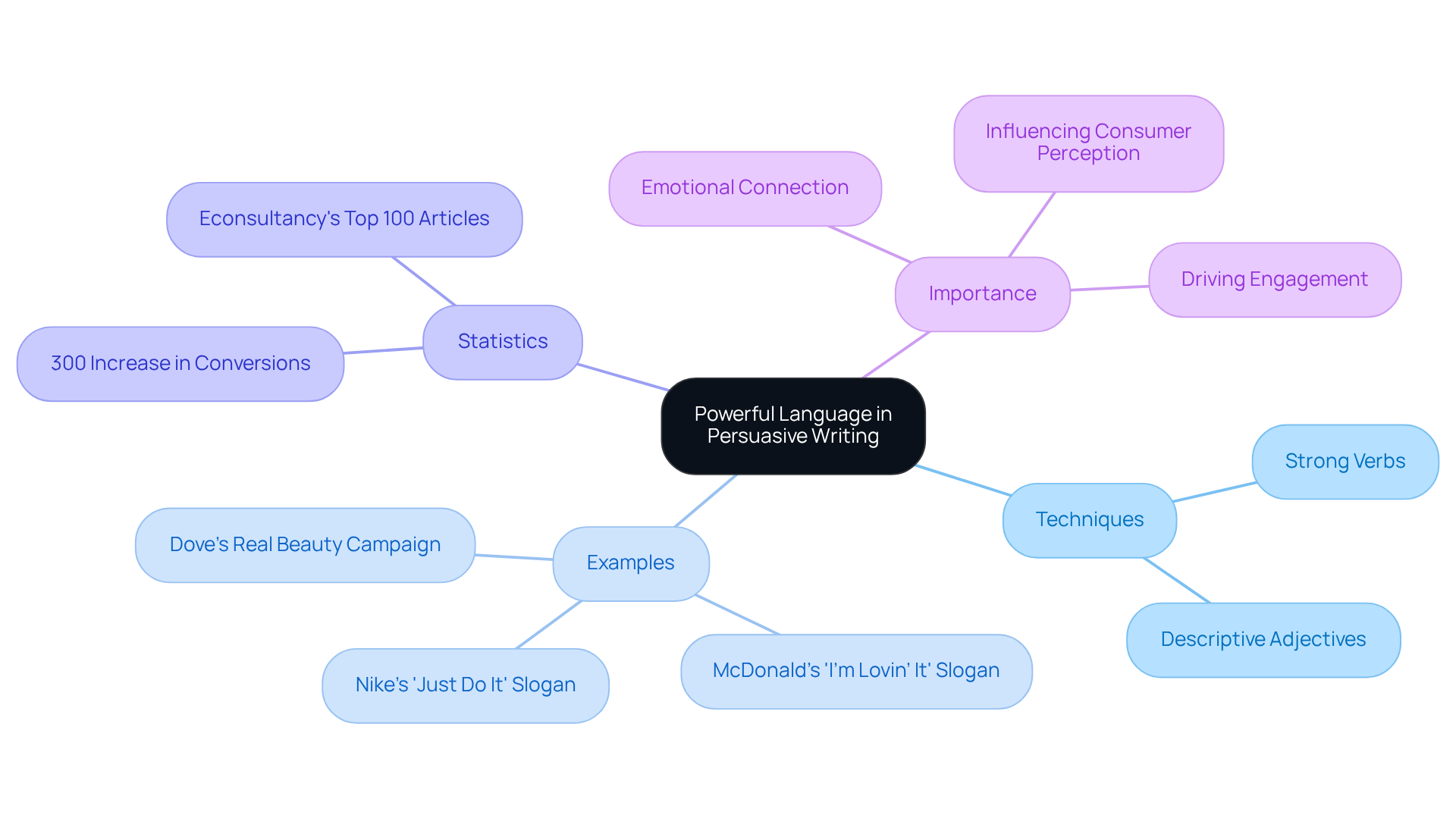
Overview
The article presents a commanding overview of various techniques in persuasive writing that significantly enhance a brand's impact and drive conversions. It asserts the critical importance of strategies such as urgency messaging, storytelling, and a deep understanding of audience perspectives. This assertion is substantiated by compelling data indicating substantial increases in engagement and conversion rates when these techniques are effectively implemented. By employing these methods, brands can not only capture attention but also foster a connection that propels action among their target audiences.
Introduction
In today's marketplace, where choices abound, crafting a compelling brand message is more crucial than ever. By mastering the art of persuasive writing, brands can not only capture attention but also drive meaningful engagement and conversions. This article explores ten powerful techniques designed to elevate a brand's impact, examining strategies ranging from urgency messaging to storytelling, along with the pivotal role of understanding audience psychology.
How can brands effectively navigate the complexities of consumer behavior to ensure their messages resonate and inspire action?
Parah Group: Conversion Copywriting for Persuasive Impact
Parah Group excels in conversion copywriting, a discipline dedicated to crafting messages that not only inform but also drive action. By leveraging psychological triggers such as urgency and scarcity, they create compelling content that resonates deeply with target audiences. This method significantly boosts conversion rates and average order values, making it an essential element of any effective marketing strategy.
Companies utilizing urgency messaging—such as limited-time promotions—frequently observe a notable rise in consumer engagement, appealing to the fear of missing out (FOMO). In fact, around 70.19% of online shoppers abandon their carts without completing purchases, underscoring the critical need for urgency in copywriting. Additionally, using relatable testimonials enhances authenticity, further motivating potential customers to engage.
As noted by Bruvi, customer testimonials and quotes from trusted sources like Forbes and CNET reduce friction and increase trust, facilitating a seamless conversion path. Parah Group's data-driven techniques in persuasive writing have demonstrated efficacy, as evidenced by a $30M clothing label that experienced a 35% rise in conversion rates after adopting optimized text and tactics, including gamified progress bars and complimentary gifts for larger cart sizes. Similarly, a $15M cleaning product label achieved an 80% increase in average order value through effective messaging and bundling strategies.
These results not only convert casual visitors into devoted customers but also solidify Parah Group's position as a cornerstone of effective communication. To implement these strategies effectively, brands should consider and authentic testimonials in their marketing materials to enhance engagement and drive conversions.

Understand Ethos, Pathos, and Logos in Persuasive Writing
Ethos represents the credibility of the writer, pathos engages the emotions of the audience, and logos relies on logical reasoning. By effectively balancing these three elements, writers can use techniques in persuasive writing to craft compelling arguments that resonate profoundly with their audience.
For example, a brand can through the presentation of testimonials, evoke pathos via impactful storytelling, and substantiate claims with logos by delivering relevant data and statistics.

Engage Readers with Direct Address Techniques
Direct address is one of the powerful techniques in persuasive writing that involves speaking directly to the reader using personal pronouns such as 'you' and 'your.' This approach fosters a , compelling readers to engage with the content. For instance, a call to action like 'Join us today to transform your business!' directly involves the reader and prompts immediate action.
By employing techniques in persuasive writing, you effectively tap into buyer psychology, ensuring your messaging resonates more deeply. At Parah Group, we recognize that such engagement is vital in Conversion Rate Optimization (CRO). Maximizing your existing resources through techniques in persuasive writing can significantly enhance profitability.
Our five-step process emphasizes the alignment of your messaging with consumer behavior, ensuring that your calls to action not only attract attention but also drive conversions, ultimately transforming your business outcomes.

Incorporate Storytelling to Enhance Persuasion
Incorporating storytelling techniques in persuasive writing enables companies to vividly illustrate their values and forge deeper emotional connections with their audience. A compelling narrative effectively highlights a customer's journey, demonstrating how a product or service addresses specific challenges. This method not only but also strengthens the organization's identity and mission.
Studies reveal that emotionally engaged clients are 50% more valuable than those who are merely satisfied. Moreover, brands with robust emotional ties possess 306% greater lifetime value than those lacking them, underscoring the financial significance of crafting genuine narratives that resonate with audiences. Additionally, 92% of customers prefer advertisements that resemble stories, and ads employing emotional storytelling are 23% more impactful, showcasing the efficacy of narrative-driven marketing.
Brands like Liquid Death have adeptly utilized storytelling to convey their mission, emphasizing the urgency of addressing plastic pollution, which resonates profoundly with environmentally conscious consumers. Research indicates that stories tagged as 'human interest' or 'personal journey' are shared 5-7 times more than product-driven or news-oriented articles, highlighting the broader impact of storytelling on engagement and sharing.
By sharing relatable experiences and customer testimonials, companies can employ techniques in persuasive writing to create narratives that captivate and drive loyalty and engagement, positioning storytelling as an essential tool in modern advertising. Genuine storytelling distinguishes companies in markets that prioritize trust, emphasizing the necessity for businesses to be sincere in their narratives.

Use Rhetorical Questions to Stimulate Thought
Rhetorical questions are powerful tools designed to provoke thought and reflection, rather than merely seeking direct answers. For instance, consider the question, 'Isn't it time you took control of your financial future?' This inquiry compels readers to and contemplate the solutions offered by the company. Such an approach not only captivates the audience but also reinforces the underlying message, rendering it more impactful.
Research shows that under high arousal conditions, clear statements are favored; however, in calmer settings, well-structured rhetorical questions can ignite curiosity and foster deeper engagement. Direct-to-consumer (DTC) companies can effectively harness techniques in persuasive writing by crafting questions that resonate with their target audience's emotional states, thereby amplifying the persuasive power of their messaging.
By strategically employing techniques in persuasive writing, such as rhetorical questions, companies can cultivate a dynamic dialogue with their audience, prompting them to reflect on their needs and the potential benefits of the company's offerings.

Craft a Clear Thesis Statement to Guide Your Argument
A thesis statement is essential; it succinctly articulates the main idea of a piece and guides the reader through the argument. For instance, a thesis like 'Investing in sustainable practices not only benefits the environment but improves customer loyalty' establishes a clear direction for the content, enabling readers to follow the argument and grasp its significance.
A robust thesis statement must be:
- Precise
- Arguable
- Demonstrable
It presents a claim that can be supported with evidence. Furthermore, anticipating counterarguments is vital for fortifying the argument, as it equips the writer to address opposing viewpoints effectively. By revising the thesis statement as new insights emerge during the writing process, writers can enhance clarity and focus.
Ultimately, a not only clarifies the writer's position but also utilizes techniques in persuasive writing to amplify the overall effectiveness of marketing content, rendering it more impactful.

Employ Repetition to Reinforce Key Messages
Repetition manifests in various forms, from reiterating key phrases to consistently emphasizing core values across all content. For instance, a brand might assert, 'Quality is our promise, quality is our priority, and quality is our guarantee.' This strategy not only solidifies the message but also for the audience. Marketing specialists assert that repetition is crucial for embedding messages in memory, as the brain requires multiple exposures to retain information effectively. Research indicates that individuals generally need to encounter a message at least seven times before taking action, underscoring the importance of diverse yet consistent messaging across various platforms.
Brands like Coca-Cola and Apple exemplify the power of repetition in their marketing strategies. Coca-Cola's 'Share a Coke' campaign effectively employed repeated messaging to forge a personal connection with customers. Meanwhile, Apple consistently reinforces its identity through memorable slogans and visuals. Such methods not only enhance recognition but also cultivate trust and loyalty among customers, making them more inclined to engage with the company over time. By strategically employing techniques in persuasive writing like repetition, brands can ensure their messages resonate deeply, ultimately driving consumer action and enhancing overall brand impact.

Understand Your Audience's Perspective for Better Persuasion
To effectively persuade, writers must delve into the of their readers. This comprehensive understanding enables the creation of tailored messages that resonate with the specific needs of the audience.
For instance, companies targeting environmentally conscious individuals can emphasize sustainability in their communications, aligning with the audience's principles and significantly enhancing engagement. Research demonstrates that personalized marketing can lead to conversion rates markedly higher than those of non-targeted campaigns.
By addressing the distinct challenges faced by various demographics, such as the increasing demand for sustainable products among younger individuals, companies can craft compelling narratives that not only capture attention but also foster stronger connections. Furthermore, 76% of customers believe that targeted advertising helps them discover new products, reinforcing the effectiveness of tailored messaging.
This approach not only enhances the effectiveness of techniques in persuasive writing but also cultivates trust and loyalty among consumers, ultimately driving success.
At Parah Group, we prioritize profitability and sustainable growth through our ongoing Conversion Rate Optimization (CRO) program, enabling data-driven decisions that directly contribute to business growth while reducing customer acquisition costs and increasing profitability.
By integrating these techniques in persuasive writing with effective CRO strategies, DTC brand owners can maximize their impact and achieve sustainable growth.

Utilize Powerful Language to Strengthen Your Arguments
Employing powerful language is crucial for utilizing techniques in persuasive writing to craft effective arguments. Using techniques in persuasive writing, strong verbs and descriptive adjectives significantly elevate messaging. For instance, instead of stating 'Our product is good,' consider a more impactful phrase like 'Our product transforms lives.' This transformation in language captures attention and instills a and significance, thereby enhancing the techniques in persuasive writing of your argument.
Research indicates that techniques in persuasive writing, particularly emotionally charged language, resonate more deeply with consumers, influencing their perceptions and decisions. A prime example is Dove’s 'Real Beauty' campaign, which effectively utilized inclusive language to redefine beauty standards, leading to a profound emotional connection with viewers.
Additionally, statistics show that companies employing new personalization technologies have experienced up to a 300% increase in conversions. By utilizing techniques in persuasive writing within your marketing copy, you establish a stronger bond with your readers, ultimately driving engagement and conversions.
As Simon Kingsnorth states, understanding the needs of your readers and crafting compelling copy is essential for effective communication.

End with a Strong Call to Action to Drive Response
To be effective, a compelling call to action (CTA) should incorporate techniques in persuasive writing that ensure it is clear, concise, and action-oriented. Phrases such as 'Sign up now for exclusive access!' or 'Get started today and transform your life!' not only create a sense of urgency but also encourage immediate action.
Research shows that techniques in persuasive writing, particularly , can achieve up to 202% greater performance than generic ones, highlighting the effectiveness of tailored messaging to specific groups. Additionally, incorporating urgency in CTAs, like 'Limited-time offer,' can significantly boost conversion rates by leveraging the fear of missing out (FOMO).
Effective CTAs guide individuals on the next steps, making them feel understood and engaged. For example, companies that employ proactive language, such as 'Need more info?' instead of 'Click here,' foster a more inviting atmosphere that enhances user interaction.
Parah Group's approach to CRO highlights techniques in persuasive writing by emphasizing the importance of aligning CTAs with consumer psychology, ensuring they resonate with the audience's pain points and desires. As Udi Ledergor emphasizes, effective CTAs should answer the 'What's in it for me?' question, reinforcing the importance of clarity.
By strategically crafting CTAs that not only engage but also drive conversions, companies can significantly improve interaction and enhance profitability. In our case studies, brands that implemented tailored CTAs saw significant increases in revenue per visitor and conversion rates, demonstrating the high ROI potential of effective CRO strategies.

Conclusion
The art of persuasive writing stands as a formidable instrument that can significantly enhance a brand's impact and effectiveness in communication. By employing a range of techniques—such as urgency messaging, storytelling, and a clear thesis statement—brands can craft compelling narratives that resonate with their target audience and drive action. This strategic approach not only bolsters customer engagement but also cultivates trust and loyalty, ultimately leading to improved conversion rates and business growth.
Key insights from the discussion underscore the necessity of understanding the audience's perspective, utilizing ethos, pathos, and logos, and incorporating powerful language to fortify arguments. Techniques like direct address and rhetorical questions further amplify reader engagement, rendering the content more relatable and interactive. The case studies presented illustrate the tangible benefits of these methods, showcasing how brands have adeptly transformed their messaging to achieve remarkable results.
In an environment where consumer attention is ephemeral, mastering persuasive writing techniques is imperative for brands aspiring to success. By integrating these strategies into marketing efforts, companies can not only enhance their communication but also forge lasting connections with their audiences. Embrace the potential of persuasive writing—not merely to convey messages but to inspire action and drive meaningful change in brand perception and performance.
Frequently Asked Questions
What is conversion copywriting and why is it important?
Conversion copywriting is a discipline focused on crafting messages that inform and drive action. It is important because it significantly boosts conversion rates and average order values, making it essential for effective marketing strategies.
How does Parah Group utilize urgency and scarcity in their copywriting?
Parah Group leverages urgency and scarcity by using psychological triggers, such as limited-time promotions, to create compelling content that resonates with target audiences and encourages immediate action.
What impact does urgency messaging have on consumer behavior?
Urgency messaging increases consumer engagement by appealing to the fear of missing out (FOMO). It has been noted that around 70.19% of online shoppers abandon their carts, highlighting the need for urgency in copywriting.
How do customer testimonials enhance conversion rates?
Customer testimonials enhance authenticity and trust, which motivates potential customers to engage. Quotes from trusted sources also reduce friction in the conversion process.
Can you provide examples of companies that benefited from Parah Group's techniques?
A $30M clothing label saw a 35% rise in conversion rates after adopting optimized text and tactics, while a $15M cleaning product label achieved an 80% increase in average order value through effective messaging and bundling strategies.
What are ethos, pathos, and logos in persuasive writing?
Ethos refers to the credibility of the writer, pathos engages the audience's emotions, and logos relies on logical reasoning. Balancing these elements helps craft compelling arguments that resonate with the audience.
How can direct address techniques improve engagement in persuasive writing?
Direct address techniques involve speaking directly to the reader using personal pronouns, fostering intimacy and urgency, which compels readers to engage with the content and prompts immediate action.
What is the five-step process emphasized by Parah Group for maximizing conversions?
Parah Group's five-step process aligns messaging with consumer behavior to ensure that calls to action attract attention and drive conversions, ultimately transforming business outcomes.
FAQs











